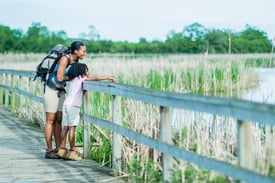


In Western cultures, over 80% of our time is spent inside, according to the New York Post. As someone who lives in the Midwest, it’s with good reason we spend much of our time inside when the windchill is -40 degrees outside; but what’s our excuse the rest of the year? For nearly all of human existence, we’ve spent most of our time outside with the shift towards indoor living only occurring over the past few thousand years.
Children now spend half as much time outside as parents did when they were children. Gone are the days of free-range parenting where kids were told to get out of the house and come home before dark. Now, the average American spends over 10 hours a day in front of electronic devices. Changes in parenting styles and technology are likely only part of the explanation for why we are spending less time outside. The more important question is: what impact is our indoor lifestyle having on our well being?
During the past 40 years, researchers from various disciplines have come to find there is an important relationship between humans and nature. In the U.S. and Canada, as we’ve learned more about this relationship, we’ve seen an increased emphasis being placed on managing the amount of time we spend inside and improving access to the natural areas around us. In 2017, NBC News ran a story about how a family doctor had prescribed spending time in her local park to a patient who was struggling with anxiety and depression. There is a practice in Japan called Shinrin-Yoku or “Forest Bathing” where individuals go out into the forest to experience nature as a meditative and restorative practice.
These examples suggest when we are disconnected from natural environments, we experience an increase in mental fatigue making it more difficult to cope with the physical, psychological and social stressors of modern life. When we foster a connection with nature, we see significant improvements in psychological and physical health.
As we continue to spend an increasing amount of time inside, we are making it more difficult for us to be the best version of ourselves. Fostering a connection with nature through spending time outside surrounded by trees, plants and animals has significant benefits to both our physical and mental health. There are many positive ways you can increase your connection with nature, even in the most urban environments.
5 tips to improve your connection with nature
- Find ways to bring nature indoors through having pictures of nature (flowers, animals, naturescapes) and houseplants around your home. Simple changes to your indoor environment can have the same peace inducing and restorative advantages as spending time outside.
- Take advantage of outdoor spaces whenever possible such as balconies, patios or your backyard. When you go out to the restaurant, choose to sit outside.
- As often as possible, use an alternative commuting option such as walking, biking, scooters or rollerblades.
- Get involved. Connect with organizations and attend public forums to advocate for protecting the greenspaces, parks and wildlife areas around you.
- And when you have time on the weekends or long vacations, take some time away from the city and explore natural environments that interest you. Even a short amount of time spent in natural environments can have a restorative effect on our mind and body.
We Can Help
VITAL WorkLife has numerous resources for members to help you find your work/life balance so you can have more time to enjoy the natural world around you. Learn more about VITAL WorkLife and our holistic approach to well being. For more information contact us online.
Sources:
https://nypost.com/2018/05/19/north-americans-lead-other-countries-in-time-spent-indoors/
https://www.cnn.com/2016/06/30/health/americans-screen-time-nielsen/index.html
https://www.nbcnews.com/health/health-news/dose-nature-doctors-prescribe-day-park-anxiety-n823421


